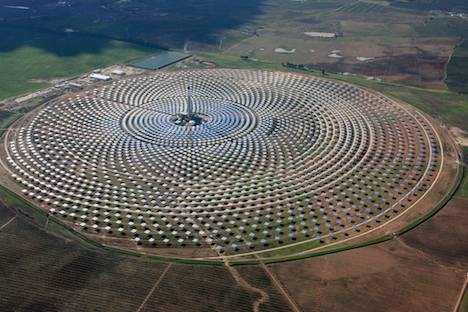Himin Solar Co., Ltd., is the big kahuna in the solar thermal market. (The pronunciation of its name does have an unfortunate homonym.) Founded in 1997 and, reportedly, started with no government subsidy,
Himin's visionary leader won the Right Livelihood Award in 2011. They focus on education, communication, research & development, manufacturing, and tourism. They exported about 100 MW of modules last year. Tourism may seem out of keeping with the other core functions of the company, until you come to China's Solar Valley.
China's Solar Valley is a city, but the factory complex includes a hotel and convention center, model houses, and Unity College in Maine has even lent them Jimmy Carter's solar panels that Ronald Reagan, in his infinitesimal wisdom, removed from the roof of The White House.
Their signature products looks like this:
 |
| Notice the tubes go right into the water tank. The ones sold in the West generally have a manifold. |
Many of the tubes are made in a 13,000 square meter plant that we toured.
It's corporate profile states:
Himin Solar Co., Ltd addresses the global concerns of rising energy
costs and environmental protection through our developments in the use
of solar energy. With our more than 15 years of experience in solar
heating systems and solar power, Himin Group's products range from solar
water heaters, solar collectors, solar panels, and split solar water
heating systems, to solar lights and PV lighting products, to name a
few. We also provide solutions for solar hot water heating projects.
Clients can rest assured, as our products are in high quality. We have
obtained the ISO9000 certificate, CE certificate, TUV and SOLAR KEYMARK
certificates on our products.
A typical Himin solar water heating system is composed of
solar thermal collectors (evacuated tube collectors/solar panel), pumps,
heat exchangers, controls, and one or more solar water storage tanks.
A little research, though, and you find:
Himin Solar's IPO was pulled amidst allegations of corruption. For our part, we were able to meet with many top managers, but learned very little about how they actually work. Most of us felt that their goal of opening 50,000 Climate Marts around the world was absurd, given that the range or products they intend to offer are mostly, though not all, useless crap that we don't need cluttering our post-2012 lives. A prime example was that hat with which each of us was presented. It has a useless solar-powered fan built into the brim. Cute gimmick and I will wear it because I am ridiculous, but...
They have 30,000 employees in Dezhou and another 40,000 spread throughout the nation. There are 3,000 students at Solar University. It is a huge enterprise in every respect.
The total constuction [sic] area od [sic]the University Town is 82,092.97 ㎡. It is
the world’s first professional education and training institution for
renewable energy, and it is also a typical work for the combination of
solar energy and crowded buildings. The building adopts over 10 items of
domestically and intemationally [sic] leading high-end technologies,
including solar cooling, heating, solar hot water, intelligent PV
sun-shading, Wenping energy-saving glass, etc.
This is the Sun Moon Mansion, which acts as a sort HQ, but sounds like the home-base of a religious sect.
You can learn more about the entire facility at
http://isesasiasun.com, but I am sorry to say they ran out of money before they could build the spa.




